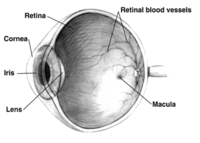
Photo from wikipedia
The unique “Handbook of pediatric retinal OCT and the eyebrain connection” is edited by Cynthia A. Toth and Sally S. Ong in 70 well-illustrated chapters. Optical coherence tomography (OCT) allows… Click to show full abstract
The unique “Handbook of pediatric retinal OCT and the eyebrain connection” is edited by Cynthia A. Toth and Sally S. Ong in 70 well-illustrated chapters. Optical coherence tomography (OCT) allows a high-resolution, non-invasive evaluation of the retina and optic nerve in newborns, infants, and children. OCT has become the most important imaging modality of the posterior segment, and is routinely used to confirm the diagnosis and monitor progression or response to therapy in many pediatric vitreo-retinal disorders. This 1st edition by Elsevier publisher is an easy-to-use, teaching handbook that provides a quick, templated, and portable guide for the interpretation of pediatric OCT scans. It takes a structural look at pediatric OCT in detail and comprehensively categorizes in 9 sections throughout more than 300 pages featuring 200 high-quality, clearly illustrated images. In the first section, the reader may appreciate a detailed introduction by the expert authors on basic principles of OCT and OCTA, image analysis, and identifying artifacts. It provides guidance to identify retinal layers and corresponding retinal intra alterations and pathologies. It is worth highlighting the excellent chapter by Du Tran-Viet et al. on OCT image acquisition, which provides guidance on how to avoid pitfalls or artifacts and describes methods to obtain an optimized scan quality in young infants and children, with many useful tips. The second section covers the analysis of pediatric OCT images including the development of the fovea or retina as well as abnormalities of the vitreous and optic nerve head. It highlights the unique aspects of retinal and optic nerve head imaging in infants and young children and its relationship to brain development. The third section presents a variety of specific considerations, e.g., ingenuity and accuracy for OCT studies in children. Chapters 4 to 10 describe a variety of diseases, e.g., inherited retinal disease, vitreo-retinal disease, infectious diseases, uveitis, trauma, and retinal detachment, as well as tumors, developmental or optic nerve abnormalities. Each section provides in detail the essential distinct OCT findings across a range of pediatric diseases, which are crucial for any pediatric ophthalmologists to evaluate the clinical status. This book will serve as a first-of-its-kind reference for pediatric retinal OCT. It contains an eBook version, providing an essential guide for both basic and advanced OCT applications in the advancing field of pediatric ophthalmology. With the “Handbook of pediatric retinal OCT and the eye-brain connection,” you can master the latest imaging methods in pediatric ophthalmology. It is an excellent reference on pediatric OCT imaging and will become a great addition to every professional’s eye care library. We strongly suggest the valuable handbook for residents, pediatric retinal fellows, or pediatric ophthalmologist as well as any colleague interested in clinical applications of OCT in pediatric ophthalmology.
Journal Title: Graefe's Archive for Clinical and Experimental Ophthalmology
Year Published: 2019
Link to full text (if available)
Share on Social Media: Sign Up to like & get
recommendations!